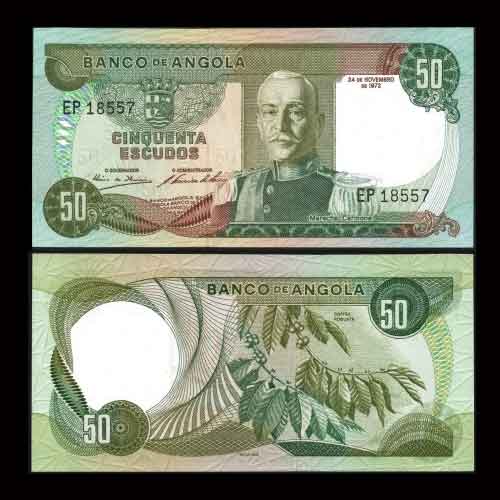Angola 50 escudos 1972 banknote
2018-11-19 Mon
Angola is a Southern African nation whose varied terrain encompasses tropical Atlantic beaches, a labyrinthine system of rivers and Sub-Saharan desert that extends across the border into Namibia. The country's colonial history is reflected in its Portuguese-influenced cuisine and its landmarks including Fortaleza de Sao Miguel, a fortress built by the Portuguese in 1576 to defend the capital, Luanda.Angola has vast mineral and petroleum reserves, and its economy is among the fastest-growing in the world. Angola's economic growth is highly uneven, with most of the nation's wealth concentrated in a disproportionately small sector of the population. Angola has diamonds, oil, gold, copper, and a rich wildlife, forest, and fossil fuels. Since independence, oil and diamonds have been the most important economic resource.
Even if the current currency of Angola is the Kwanza, The escudo was the currency of Angola between 1914 and 1928 and again between 1958 and 1977. It was subdivided into 100 centavos with the macula worth 5 centavos and was equivalent to the Portuguese escudo.
In 1921, bronze 1, 2 and 5 centavo and cupro-nickel 10 and 20 centavo coins were introduced, followed the next year by nickel 50 centavos. In 1914, the Banco Nacional Ultramarino introduced notes in denominations of 10, 50 and 50 centavos.
The note depicted in the image alongside is 50 escudos banknote issued in 1972. The front has Marshal Antonio Oscar de Fragoso Carmona, the 11th President of Portugal (1926–1951) depicted in the center with text and coat of arms to left. The back has a Robusta coffee plant (Coffea robusta). It has about twice as much caffeine as arabica. This green note has the Watermark of the Portrait of Marshal Antonio Oscar Fragoso Carmona.
Image Courtesy: Numismatica Bilbao
Latest News
-
Gold Pagoda of Vijaynagar Empire King Deva Raya I
2024-04-10 WedKing Deva Raya I of the Vijayanagara Empire was a patron of Kannada literature and architecture. He ...
-
Silver Denarius of Septimus Severus
2024-04-05 FriLucius Septimius Severus served as the Roman emperor from 193 to 211 AD. Severus sat on the throne o...
-
Extremely rare 'Malaharamari' type Gold Gadyana of King Guhalladeva-III Sold for INR 611000
2024-04-03 WedTribhuvanamalla, also known as Guhalladeva III, was the ruler of the Kadamba dynasty. His reign coin...
-
90 Years of RBI
2024-04-02 TueOn 1st April, PM #Modi unveiled a special commemorative coin marking 90 Years since the foundation o...
-
Silver Denarius of Julia Mamaea
2024-04-02 TueJulia Avita Mamaea, a Christian Syrian noblewoman, was the mother of Roman Emperor Alexander Severus...

